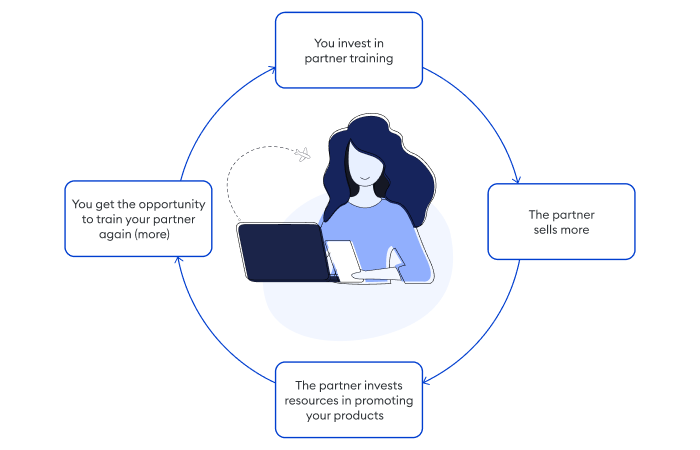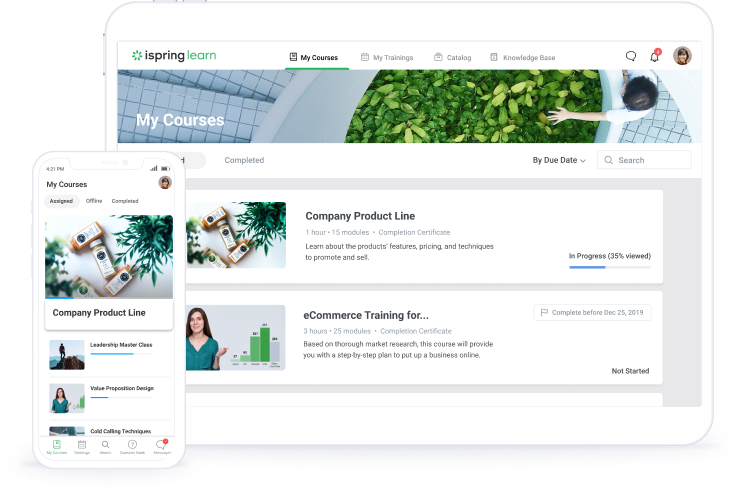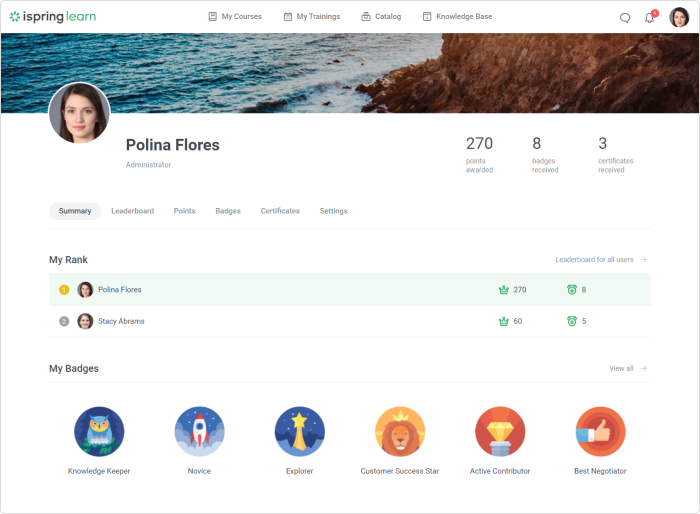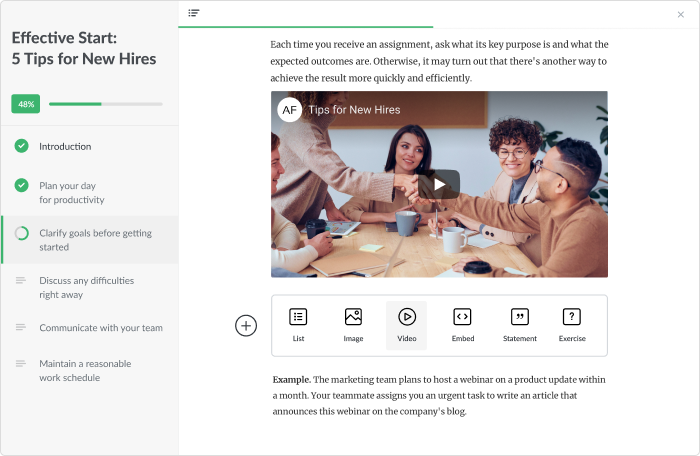Channel Partner Training That Helps Your Business Grow

In this era of globalization, channel partner training is important, as fewer companies are willing to settle for local markets. They want their products and services to be distributed nationwide and worldwide. This is why companies seek out partners that can help them expand their market.
This article will explain what having a channel partner means and how to create a successful channel partner training program, explore channel partner programs, and use modern technologies to launch and manage it.
What is Channel Partner Training?
Channel partner training is the process of providing partners with the foundational knowledge they need to promote, sell, and serve your products and ensure a high level of customer satisfaction and loyalty.
Channel partner training becomes essential when the first external partner joins your business, and even more so as you gain more partners and their sales increase.
The Benefits of Channel Partner Training
Partner sales can help greatly in terms of scaling your business. However, simply providing your partners with your product and advertising brochures won’t generate sales. You need to provide reseller training to ensure that they’re equipped with the right knowledge and skills to win customers’ hearts and budgets.
Investing in a comprehensive partner enablement program will allow you to realize many benefits, such as:
- Increased sales
If your channel partners know how to promote effectively, present convincingly, and sell your products easily, they achieve better results and bring you more revenue in a shorter period.
- Reputation risk management
If your channel partners receive more product and company information from you, they are more likely to accurately represent your brand and communicate your values and vision.
- Winning when competing with other vendors
Usually, your channel partners sell your products, those of your competitors, and other goods as well. They divide shelf space, perform co-marketing, and execute sales rep motivation programs among their suppliers. That means you must compete with other vendors in this “internal market” for a channel partner’s time and resources.
Training your channel partners to sell your product effectively can lead to increased sales and earnings. The more opportunities you have to collaborate with your channel partners, the more income they will produce by selling your brand’s products. This encourages them to promote your products even more, which boosts sales again!

- Solid relationships with partners
A well-planned training program shows that you are willing to invest time and effort in building the channel partner network and intend to establish long-term relationships.
This will boost revenue, build trust and advantage, and cut costs (including the costs of solving problems that poorly trained channel partners can generate). That is why channel partner training programs are beneficial.
How to Create a Channel Training Program
Now, it’s time to figure out how to create an effective channel training strategy that covers all the important aspects that your channel partners need to know.
Following these steps will bring you the best results:
Step 1. Determine your goals
An objective like “All partners will pass the final quiz and get certificates by the end of the month” will only give you mental satisfaction. If your company wants to enter new regions, it must find and establish new partners. You must focus on your channel partner onboarding program to enable new resellers faster and motivate them. Your goal can be to “speed up channel partner onboarding from 4 to 2 weeks” or to “increase new channel partner retention by 40%.”
If your company wants to increase a product’s market share, you must train your partners in product sales and set a goal like “increase channel partners’ sales of our product by 20%.”
Step 2. Define your audiences and their roles
Like your company’s employees, your channel partners’ employees have different tasks and responsibilities.
Define partner companies’ departments whose performance affects your collaboration (e.g., sales volume, customer satisfaction, repeat sales) and suggest a comprehensive training program.
Below, you’ll find some ideas for building your channel partner training strategy based on the three types of partners.
| Channel Partner type | Training audience | What to include |
| Distributor | Sales departments that present and sell your goods to resellers |
|
| Value-added reseller (VAR) |
|
|
| Franchises |
|
|
Step 3. Decide what knowledge each target group needs
There are two types of corporate training programs: onboarding training (helping the learner get into the nuts and bolts of the processes regardless of their job position) and specialized training (covering specific aspects depending on the employees’ roles and goals).
Let’s list basic topics to be covered in almost all onboarding programs.
- Company overview: This will help your partners better understand what kind of organization you represent. Let them know about the company’s history, key personalities, goals, and mission. Tell them a short motivational story about the value you provide to the world and how you inspire others to share your vision.
- Rules, standards, and expectations: What communication style is to be used to interact with company representatives and customers, if there is a dress code in the company, and how partners can share their ideas and suggestions with the head office.
Give channel partners information about your company’s structure and which departments to contact with questions.
- Partner product training: What makes your product valuable, why customers buy it, what problem does it solve, and who uses it? A detailed product description, features, and benefits will help your partners target the right audience and communicate better.
When it comes to specialized training programs, the content will depend on what departments or job positions you are addressing.
- Partner sales departments. Since these people are selling your products to clients worldwide, you need to train their sales reps the same way you train your internal employees by providing channel sales training.
Here are some topics to cover: how to present your product and its benefits, how to explain its value and differentiate it from competing offerings, how to justify the price to customers, and the way to offer discounts.
Do some research to understand the level of professional skills that your partners’ sales teams possess (e.g., you can apply to a partner’s office as a mystery shopper to evaluate the level of services they offer). They may need basic sales training on how to persuade prospects to purchase or how to handle objections.
- Partner marketing teams. If you want your partners to promote your product, you must give them information about your target audience, the results of your research, and examples of successful marketing campaigns. Detail how to use them and to what degree partners can change your brand identity.
- Production staff. Channel partner training should teach production workers how to maintain the quality of your product and services, from baking cinnamon cakes to installing alarm systems.
- Partner management teams. You can help channel partners manage risks and operate safely. In their training program, cover legal and tax requirements, team building and motivation, and operating and administrative cost optimization.
Step 4. Choose a training format that suits your audience
You need to decide how to inform your trainees. You can choose brick-and-mortar training rooms and trainers traveling from partner to partner, email training materials, or go online with live webinars, self-study materials, or a mix of these.
Some training methods may be more comfortable for trainees, depending on their work process and conditions.
Here are the basic questions you need to find answers to:
- Where do they work? Do they work in offices equipped with PCs with headsets or do they work “in the field” with only their smartphones available?
If your trainees work in the office
Advantages
- A stable internet connection.
- Any adequate training format (including video and audio) is acceptable.
- An opportunity to include more details on slides and images.
- Trainees can easily switch between several information resources (online database, your website, and a training platform).
Disadvantages
- All activities and communications need to be scheduled during working hours.
If your trainees work in the field
Advantages
- Trainees can learn anytime, anywhere.
- Learners can take training courses right at their workplaces and put all the necessary knowledge into practice.
Disadvantages
- Trainees may not have headphones with them, so don’t use videos as a primary source of information.
- Slides filled with texts and minor details will be difficult to read.
- A stable internet connection is needed.
- When will they take the training? Will they be allowed to pause their workflow for an hour or more to take part in your training activities, or will they only have brief breaks between their regular work activities?
| Working hours dedicated to training | Short breaks between working tasks |
|
|
- How well-equipped are they with the necessary devices and technical knowledge?
We tend to assume that others live and work in the same conditions as we do,
but employees’ technical equipment and computer literacy can vary greatly by region
and country.
| Modern devices with a stable internet connection and a tech-savvy staff | Limited technical options or skills |
|
|
Step 5. Find ways to motivate your channel partners
Remember that partners are not employees and cannot be forced to train. Traditional motivational systems also won’t work. To engage partners, make them feel valued and needed on your team and that your business values their contribution to the goal.
Training programs can bridge the gap between your office and partners by sharing business goals and successful partner results. In general meetings (webinars or offline events), encourage members to share their experiences and solve problems.
Step 6. Make partners’ feedback your inspiration
Creating a channel training program as a one-time event is the biggest mistake. No training can be time-saving, engaging, and efficient. You can always improve it.
Thus, involve partners in training program discussions. Ask them questions about the program’s efficacy and suitability:
- Are online learning materials clear and easy to understand?
- Do learners feel prepared to start working with your products, and are they equipped with all the information they need?
- Did they get answers to all their questions? If not, do they know where they can find additional information?
- Are there any conflicts with the internal business process or regional situation in different countries?
Encourage your partners to contribute to new programs and online courses and share their ideas. This helps you and your trainees communicate and understand their needs. This collaboration can motivate you and help you stand out from other vendors the partner works with.
Channel Partner Training Challenges
With a step-by-step channel partner training strategy, you may think you can create a compelling program and overcome channel partner training challenges. But allow us to warn you of some common challenges so you can prepare adequately.
- Ever-increasing training expenses. As your partner network expands, you’ll need to grow your training team and increase your training expenses accordingly.
- Challenges in training small or distant partners. Partners that are smaller or distant (or both) may never get as much attention from your trainers as the big players will. This means they will have even less chance to succeed in this partnership.
- You can’t be sure that training materials are used effectively. Your partners may never see your new presentation because it’s in the spam or read-it-later folder. The partner company’s new hires may not have access to training materials either.
- To keep partners informed of the latest updates, you’ll need to persuade them to train regularly. You’ll always want to give partners new information about your new hires, products, and sales and promotions, but they won’t interrupt their workflow with a new training program.
How to Automate Channel Partner Training with an LMS
Most of these issues can be resolved by moving training online. This will enable you to create a structured, easy-to-manage database and provide training materials to all your partners worldwide.
With a learning management system (LMS), most routine tasks can be automated. Learning management systems let you assign and monitor training programs for trainees online.
The right learning management system can perform most of these processes automatically:
- Remove repetitive tasks. Manually completing course assignments, sending out webinar invitations, and giving deadline reminders take time and run the risk of human error. Automating partner training saves your staff time and ensures coordination.
- Partner enablement. You need to provide new partners with onboarding and product training, track their progress, and test their knowledge. An LMS lets you set partner onboarding rules once and execute them automatically when a new partner joins your network.
- Real-time monitoring of the training progress. An LMS can automatically generate reports on trainees’ progress and email them to you with the frequency that you choose.
- Informing partners about news and updates. No more manually sending emails to each partner on your list and calling to confirm receipt of same. Uploading content to your LMS makes it available to everyone with a click and sends automatic notifications.
LMS features that make training easy
Make interactions with your platform easy and clear, so your partners don’t waste time trying to access it or search for the information they need. Here are some LMS features that can help:
Single sign-on
This technology allows users who are authenticated on a partner’s website or any other portal to access the LMS learning portal without entering their credentials each time, thereby preventing trainees from losing passwords and wasting time.
Mobile app
A mobile app provides information on any device, anytime. It removes many restrictions and lets partners study when and where they want. Partner sales representatives in shops, showrooms, and client offices without computers will benefit from this feature.

The iSpring LMS mobile app allows trainees to download channel partner marketing courses on mobile devices and take them even when no internet connection is available.
Multi-tenancy
As mentioned previously, partner teams that you are going to train comprise different types of employees: newcomers and old-timers, sales reps and tech support teams, and juniors and big bosses. Dividing learners into groups and managing information access levels will help you create tailored learning journeys for every job position.
Efficient scheduling tool
Allowing your partners to see the entire picture of ongoing training activities and assessments will help them plan their time better and meet all deadlines. An LMS like iSpring LMS makes training channel partners effective and easy to manage for providers.
LMS Features for partners’ motivation
Now, let’s think about the best ways you can motivate partners to take your training courses (and take them seriously).
Gamification
Gamification implies the awarding of badges for completed tasks and leaderboards or charts showing the trainees’ results.

The gamified learning management system will automatically award points and badges honoring leaders, and stimulating the team to move faster and study harder.
Advanced tracking
You can offer discounts for partner companies or bonuses for the best students if your learning management system lets you estimate the progress of a specific user or group, or provides stats for each learning item.
LMS features for easy training management
This third group of features will make life easier for the team responsible for channel training.
Auto-assignment
As previously mentioned, this feature streamlines the training process. The learning management system will operate according to the rules that are assigned, e.g., send all new users in the “Newcomers” group or assign all sales reps a mandatory product knowledge assessment every quarter.
Built-in course authoring tool
A tool that allows you to update existing materials easily or create new ones in record time is a real time-saver. Make sure that the content you create with your authoring tool will display perfectly and be tracked by your corporate LMS. Ideally, both of them should be provided by the same vendor.

A lightweight, cloud-based online authoring tool helps facilitate the creation of interactive page-like courses online right in the iSpring LMS admin portal.
Accessible support team
If you want to improve and streamline your partner training programs regularly, having high-level tech support from your LMS vendor will help you gain many insights and exciting ideas to implement.
To Sum Up
Well-informed and highly trained partners can help your business expand into new markets. You can improve your channel partner training program by moving it online and using an LMS to make it more engaging and easier to manage. Take your first step toward finding the right LMS for developing your business with a trial of iSpring LMS. Get a free 30-day trial right now and see iSpring LMS in action.



